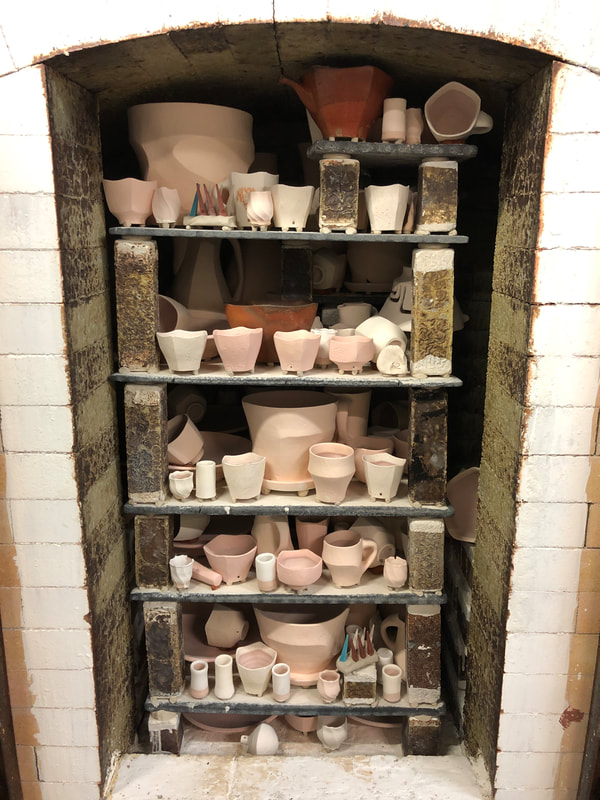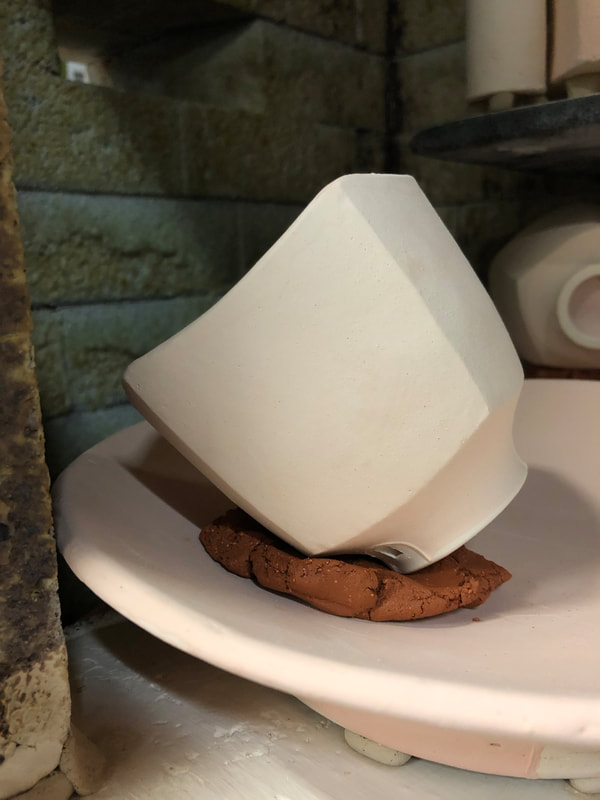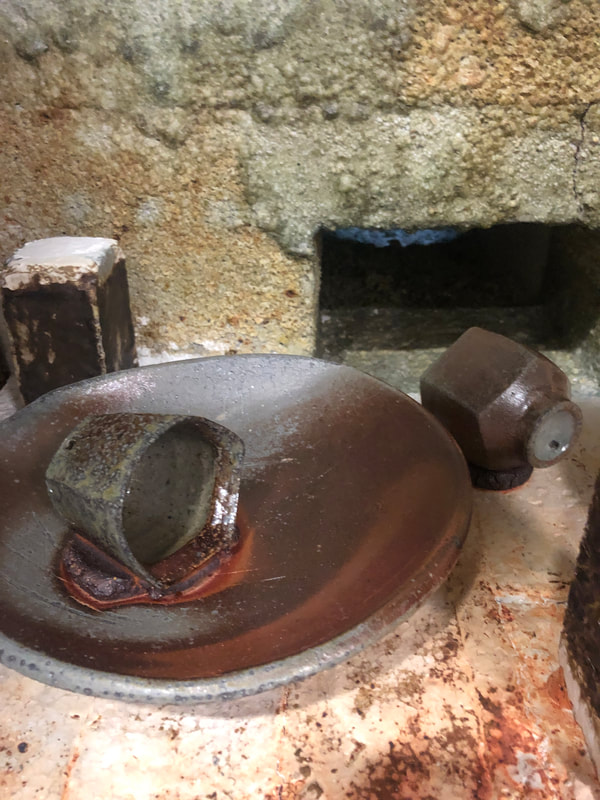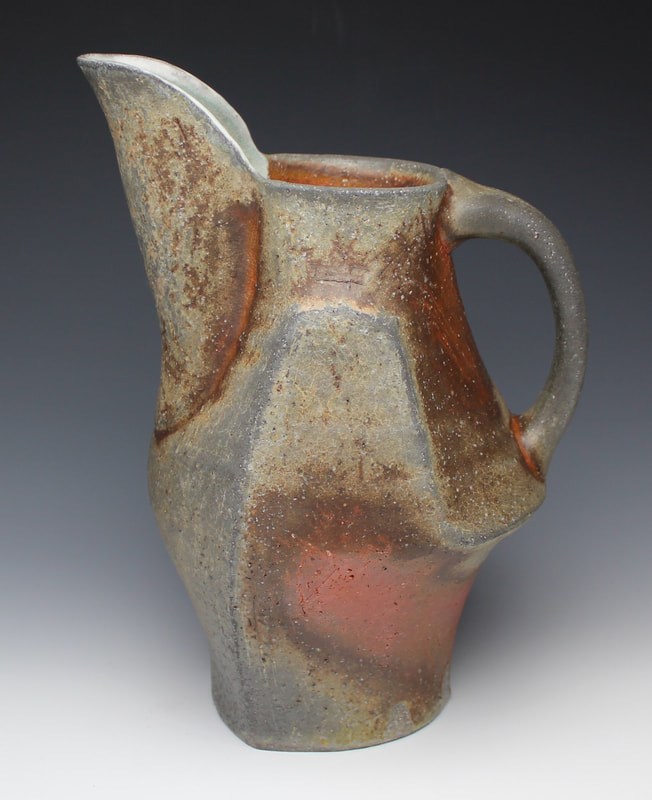|
How did you get into soda firing? "My first experience with soda firing was at the University of Wisconsin-River Falls. During my first semester, some friends invited me to do some salt firings with them in the salt/soda kiln. It just felt right! My second semester, as a class project we took down the salt/soda kiln and began rebuilding it which took until my third semester. By then I had dug around on the internet and discovered the mystical soda firing. Once the kiln was constructed I began playing around. I had no idea what I was doing and was just following the lead of what my friends did in the salt firings. I was blown away by the surfaces out of my first firings and hooked!" Do you solely soda fire? "These days I pretty much only soda fire. When I was in school and just out of school in 2019 I was also woodfiring. I had developed a clay body and used a slip and liner glaze that worked pretty well in either atmosphere. When I was woodfiring, I mostly fired with this crew at Zac Spates’ pottery that was also interested in reduction cooling the small anagama that we were firing. This is not too far off of what I was doing in the soda kiln at the time and found many similarities in the surfaces. The wood being a little more refractory of a material than soda would produce some dryer surfaces but we usually fired hot enough to vitrify the clay and create some good glaze melt on my slip. Up until summer of 2020 I was just using that one clay body, slip and glaze which didn’t leave me with too much to juggle beyond the kiln. My research has mostly revolved around the firing and atmosphere of the kiln; I am particularly interested in the down-firing and how that interacts with the ceramic materials. Recently, I have been working with clay bodies that are more refractory than standard boxed clays or my own body that I have been working with over the past couple of years. With this clay body research, I am planning on sticking to soda firing as the clay bodies will most likely be a little to refractory for the wood kiln. They sure bring out some exciting results in the soda kiln though! If I were to say anything about juggling research with multiple firing atmospheres, it would be to find a set of materials that work for the various kilns and to work with similar firing schedules." What inspires your artwork, and does that relate to part why you soda fire? "My work is, of course, influenced by nature and particularly natural patterns that occur through the nature of processes. Going beyond the broad concept of nature as source material, I am interested in memories created through process. How process interacting with material can leave a mark and cause a memory to form. Through working with materials that are reactive to touch and fire, forming in certain ways and firing the kiln in particular ways, I am can showcase a timeline of memories through each vessel. Using handmade pottery daily in my home, I can review these memories that other makers form and evolve them with my own memories. I hope that through daily use, the memories made through my process can be evoked while the user evolves them with their own memories." What is your unique aesthetic approach to soda firing? "The clay that I make has large grog included in it which creates textures as I work. The vessels are shaped in ways to influence and promote intense flame variation on the surfaces. The angles, planes and facets help create more dramatic patterns, while rounded curved areas catch a gentle variation. Loading the kiln is a very important consideration in my process as well. I place object touching each other and stack items to influence the flame even further. I also use wadding that is made up of Newman fireclay to produce dramatic, red wad marks. I aim to decorate my pots with an interaction between ceramic material, soda glaze and atmosphere. I utilize a slip that produces a variety of colors and control the atmosphere of the kiln to produce that variety of colors." What clays, flashing slips, or glazes are you working with to create your unique soda fire surfaces? "As I answer these questions in fall of 2020, my answers are in a bit of flux (get it?) but I will tell you where I am currently at in my research. My work has been primarily made of the same clay body over the past couple of years. I use a porcelaneous stoneware that I developed in undergrad. It is trusty, easy to thrown and is a nice backdrop to my slip as it is lighter in color. The slip that I use is a variation of a shop slip from the UWRF studios. Lastly, I use one liner glaze for my work; it is a very trusty blue Celadon that does not mind a good amount of reduction on the cooling; this is also a variation of a UWRF shop glaze. You can find recipes for all of these on my website! Now for the parts of my material usage that are in flux. In spring of 2020 I was awarded the Ceramic Artist Jerome Project Grant from Northern Clay Center to research down-firing soda kilns and its relationship to ceramic materials. With this, I have dived into developing new clay bodies and slips! Over the past couple of months, I have formulated and mixed many different clay bodies with around a 1 alumina to 3 silica ratio. What I am looking for with these is a clay body that has nice flashing in the soda kiln but also produces a soda glaze that has depth and color. I have found a couple clay bodies that I am really excited about but they are not as workable as my usual porcelaneous stoneware. I am still continuing to test the successful clay bodies but have also began developing slips that are based off of these clay bodies. I have yet to test these slips but am excited to do so in my next firings!" What is a typical soda-firing schedule? "My soda firing schedule is very important to my material usage and vice versa. My firing schedules are also changing with each firing; I have so many questions about soda firing and not enough answers! With each firing and change in schedule I may answer some of my questions, but usually have many more, leading me to change the schedules. Recently, I have not been worrying about reducing the kiln on the way up and aim to fire as efficiently as possible so that I can put as much of my own energy into the down-firing as I can. I typically begin spraying soda into the kiln around ^9 and spray once more around ^10. I keep the kiln in reduction from when I first begin spraying until I am finished with the down-firing. I also have been practicing soaking the kiln between spraying soda and after my final session of spraying / before the down-firing begins. I aim for at least an hour both times; I find that this helps melt the soda glaze and creates less blistering in it. Something that is consistent with all of my firing schedules is the fact that I aim to down-fire for at least 6 hours and to 1600°F. Recently, I have been keeping the kiln in reduction during the entire down-firing except for a brief moment of reoxidation at 1900°F. I find that this brings out some interesting peachy colors and can brighten up the flashing. Another experiment that I have been working on is utilizing steam to create more reduction in the kiln. A general thought on this is that introducing steam into the kiln will produce more pressure and possibly displace the oxygen. I have also found that introducing steam into the kiln makes the flame dance around more. I do this by soaking soft brick in water and plugging up the spray ports with them; I replace them every half hour or so. This steam reduction is still a mystery to me and I can only speak from a couple firings of experience and chatting with others. If you know more about this concept lets chat! As I said before, I have an endless amount of questions that I want to ask the kiln. Here are a couple of them to maybe influence your research! -How does one period of reoxidation effect color if done at various temperatures during the down-firing? -How does holding the kiln at a various temperatures effect crystal growth during the down-firing? -How would crash cooling them kiln then beginning a soak at various temperatures effect color and crystal growth? -Does introducing more steam into the kiln during the down-firing produce more dramatic effects? -What if the kiln is down-fired for as long as it was fired up in temperature?" Cone 10 soda firing: clay, slip, glaze and wadding recipes:
More about Beck. "As many are, I was interested in art as a child. My Aunt went to school for art and was also my babysitter; she spent time teaching me things as a young child like drawing and shading. Since then I wanted to become an artist; art was always what I was most interested in school and in high school I was lucky enough to be introduced to pottery. I instantly fell in love and have not stopped making pottery since; it has now been 8 years that I have been making pottery and I now hold a Bachelor of Fine Arts in Ceramics from the University of Wisconsin-River Falls. Beyond pottery, I really enjoy music. Due to Covid, I miss going to shows and enjoying the lively music scene that Minneapolis / Saint Paul has to offer. I now substitute this with watching concerts on YouTube occasionally and supporting artists by purchasing vinyl from them directly or at my local music shop. An album that I am really loving that I recently got is The Brian Jonestown Massacre’s self-titled LP from 2019. I also love to hike and go camping; my favorite state park for those is George Crosby Manitou State Park near Finland, MN." Parting Words "As I mentioned before, I was lucky enough to be award the Jerome Ceramic Artist Project Grant and part of my research was putting together a soda firing resource for others! You can find details on each of my firings during this grant period with schedules and thoughts. I also have my recipes for clays, slips, glazes and wadding posted. Disserting information is very important to me and I absolutely respect Lisa for doing so as well! All of this information can be found at my website." Check out more of Casey's work on Instagram, and his online shop. Did you love this interview?
Be sure to join my Soda Fire Educational Series to keep learning more about soda firing by clicking here. To read the archive of other soda fire artist interviews and articles click here. |
Hi, I'm Lisa the artist and creator of this content.
Here on my blog I share behind the scenes, events, and activities related to my art. GET INSPIRATION AND SPECIAL DEALS DELIVERED STRAIGHT TO YOUR INBOX!
Categories
All
Archives
February 2024
|



























 RSS Feed
RSS Feed